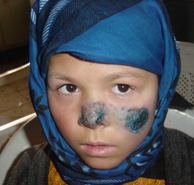 Kabul is considered the major focus of anthroponotic cutaneous leishmaniasis in the worldAnthroponotic cutaneous leishmaniasis is a major public health problem in Afghanistan. The disease is caused by L. tropica and transmitted by the sandfly, Phlebotomus sergenti. Kabul is currently the largest focus of anthroponotic cutaneous leishmaniasis worldwide. In Afghanistan, 10 out of 34 provinces are badly affected. The estimated incidence at national level is over 200 000 cases and the total population at risk is estimated to be 13 million. Among the 10 targeted provinces, Kabul has the highest burden: 17 425 out of 41 072 new cases reported in 2009 were from Kabul.
Kabul is considered the major focus of anthroponotic cutaneous leishmaniasis in the worldAnthroponotic cutaneous leishmaniasis is a major public health problem in Afghanistan. The disease is caused by L. tropica and transmitted by the sandfly, Phlebotomus sergenti. Kabul is currently the largest focus of anthroponotic cutaneous leishmaniasis worldwide. In Afghanistan, 10 out of 34 provinces are badly affected. The estimated incidence at national level is over 200 000 cases and the total population at risk is estimated to be 13 million. Among the 10 targeted provinces, Kabul has the highest burden: 17 425 out of 41 072 new cases reported in 2009 were from Kabul.
The disease exhibits strong clustering of cases at the household level, showing a significant correlation with elevation: those living on upper floors of apartment blocks are less likely to have either active lesions or scars. Risk of anthroponotic cutaneous leishmaniasis is also associated to the presence of active lesions among other household members. Migration and displacement contribute to increasing numbers of new cases annually. Research conducted in Kabul showed that for a 1% increase of migrants into a district of Kabul, the odds of active lesions being seen rose by 12%. Prevalence increases with age up to 15 years, after which levels decrease, presumably due to the acquisition of immunity. The majority of lesions occur on the head and upper arms, and although rarely fatal cause severe social stigmatization. Mucocutaneous lesions are very rarely seen, but secondary bacterial infection of lesions is common, though figures remain limited.
Zoonotic cutaneous leishmaniasis, caused by L. major, is endemic in the northern rural areas of the country, close to the Amu Darya River. The vector is Phlebotomous papatasi and, possibly, Phlebotomus caucasicus. In 2005, a first outbreak was reported in Mazar-i-Sharif.





 Manual for case management of cutaneous leishmaniasis in the WHO Eastern Mediterranean Region [pdf 195Mb]
Manual for case management of cutaneous leishmaniasis in the WHO Eastern Mediterranean Region [pdf 195Mb] Framework for action on cutaneous leishmaniasis in the Eastern Mediterranean Region 2014–2018 [pdf 364kb]
Framework for action on cutaneous leishmaniasis in the Eastern Mediterranean Region 2014–2018 [pdf 364kb]